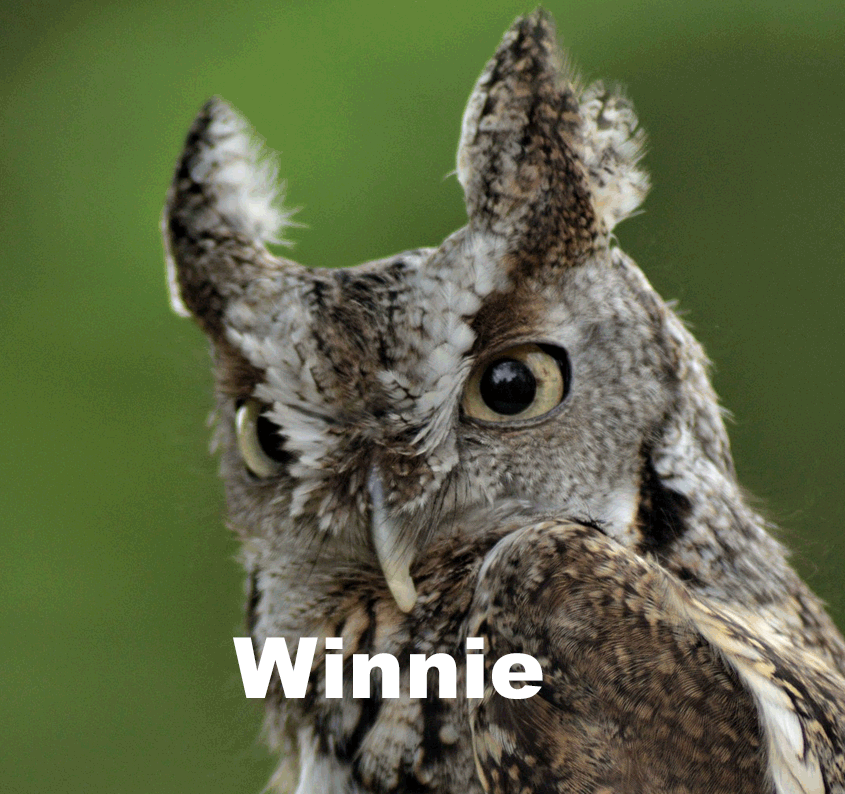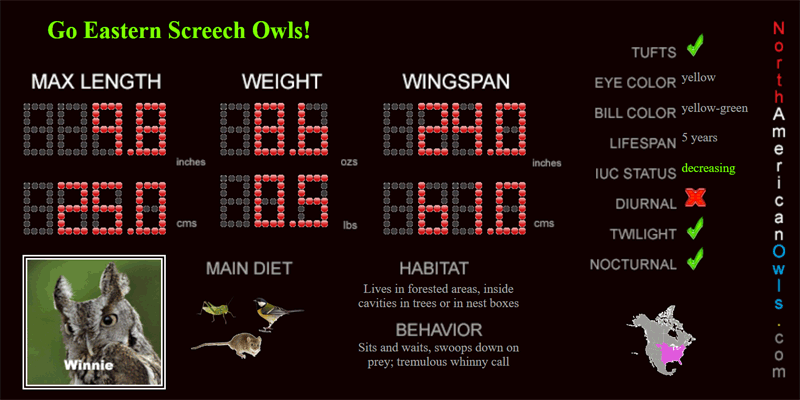
photo credit: kitkat1662
Bathing Beauty
February 18, 2025
EMCEE: Ladies and gentlemen, the Eastern Screech Owl, Megascops asio.
EASTERN SCREECH OWL: Before I answer your questions, I thought I'd highlight some of the praise that I have been receiving lately on the information superhighway. According to the website of the Hawk Mountain Global Raptor Conservation organization, we Eastern Screech Owls are the most common feathered predator in urban areas1. Thank you for that.
Oh, yes, and the no-doubt fine folk at the Owl Institute report that my species has the most varied diet of any North American Owl2. Hear that, kids? Be sure to clean those plates of yours, vegetables and all, before heading outside to play. Just remember that Winnie the Screech Owl said so.
What else?
Oh, and the Observer Today website in Dunkirk, New York, has a fine write-up on yours truly from December 2024 by a nature educator named Emma Roth3. Emma gives us to understand that my species can eat 1,000 mice in a year. Can you imagine that? Mind you, that's subject to availability. I'm also goods with birds, lizards, frogs, and insects.
But that's enough about me.
What am I saying, we can never say enough about Eastern Screech Owls, right, folks? So how about a few questions on the inexhaustible topic of yours truly? Yes, you, ma'am.
Speaking of your diet, are you exclusively carnivorous?
Guilty as charged, your honor.
And are you nocturnal?
Yes, I am an old-school owl. I prefer to hunt at night.
I hear that you have a vocalization that sounds like the whinny of a horse. Is that true?
Yes, indeed.
Can you make that sound for us now?
Well, you have really put me on the spot, haven't you?
Sorry, I just thought that...
No problem. Just let me prepare myself here. Mi mi mi mi mi! Okay, here I go...
[Eastern Screech Owl whinnies]
How's that?
Oh, that's wonderful!
Why, thank you so much.
What are some of your nicknames?
Great questions! We Eastern Screech Owls actually have a lot of nicknames. They call us Scritch Owl, Little Horned Owl, Shivering Owl, Whickering Owl, Whinnerying Owl, Spirit Owl, Dusk Owl, Cat Owl. This will all be on the test, guys, so pay attention.
Let's see, where was I? Oh, yes, we are also called the Ghost Owl, the Squinch Owl, the Demon Owl, the Death Owl... and then there's my favorite nickname. The French call us Le Petit-Duc De L'est, or the Little Duke of the East4.
Whoa, back up a minute, please. Why do they call you the Death Owl?
Well, I guess some folk are just superstitious. You see, there's a legend which holds that our owl calls are always followed by death and disaster.5.
I hear that you Eastern Screech Owls like to take baths. Is that true?
Absolutely. There is nothing more refreshing than having a good soak. Check out this video filmed in Texas in 2011. It shows you that Eastern Screech Owls that bathe together, stay together... at least till the young ones are fully fledged!
I'm jealous. All right, one more question and then I'm going to go have a soak. Yes, you, ma'am.
Yes, do you have any predators?
Yes, indeed. We Eastern Screech Owls have many enemies.
Can you name some for me?
Well, you've got your minks, your weasels, your raccoons, your skunks...
Oh, my.
And I'm ashamed to say that we are even attacked by Great Horn Owls, which are basically three times our body length, by the way. I'm, like, 7 inches tall and they are like 24 inches tall or so.
Oh, dear.
And don't forget cats. Speaking of which, you guys would be doing me a big favor if you kept your cats indoors. We Eastern Screech Owls simply cannot abide those creatures.
Speaking of cats, don't you guys make a kind of purring noise sometimes?
Well, we do make a variety of unusual vocalizations, some of which might be characterized as purring.
Could you demonstrate for me, please?
I would be delighted to. Hold on while I get ready again. Mi mi mi mi mi! And here I go on 1, 2, 3...
[Eastern Screech Owl purrs]
Catch that? Here, I'll do it again.
[Eastern Screech Owl purrs]
Thanks for the questions! I'm off to the nearest bird bath!
EMCEE: Ladies and gentlemen, the Eastern Screech Owl, Megascops asio.
1: Eastern Screech Owl, Hawk Mountain Global Raptor Conservation
2: Eastern Screech Owl, Owl Research Institute
3: Meet the fierce, adorable Eastern Screech Owl, Observer
4: North Carolina, Swamp School
5: Eastern Screech Owl, Virginia Living Museum
February 18, 2025
EMCEE: Ladies and gentlemen, the Eastern Screech Owl, Megascops asio.
EASTERN SCREECH OWL: Before I answer your questions, I thought I'd highlight some of the praise that I have been receiving lately on the information superhighway. According to the website of the Hawk Mountain Global Raptor Conservation organization, we Eastern Screech Owls are the most common feathered predator in urban areas1. Thank you for that.
Oh, yes, and the no-doubt fine folk at the Owl Institute report that my species has the most varied diet of any North American Owl2. Hear that, kids? Be sure to clean those plates of yours, vegetables and all, before heading outside to play. Just remember that Winnie the Screech Owl said so.
What else?
Oh, and the Observer Today website in Dunkirk, New York, has a fine write-up on yours truly from December 2024 by a nature educator named Emma Roth3. Emma gives us to understand that my species can eat 1,000 mice in a year. Can you imagine that? Mind you, that's subject to availability. I'm also goods with birds, lizards, frogs, and insects.
But that's enough about me.
What am I saying, we can never say enough about Eastern Screech Owls, right, folks? So how about a few questions on the inexhaustible topic of yours truly? Yes, you, ma'am.
Speaking of your diet, are you exclusively carnivorous?
Guilty as charged, your honor.
And are you nocturnal?
Yes, I am an old-school owl. I prefer to hunt at night.
I hear that you have a vocalization that sounds like the whinny of a horse. Is that true?
Yes, indeed.
Can you make that sound for us now?
Well, you have really put me on the spot, haven't you?
Sorry, I just thought that...
No problem. Just let me prepare myself here. Mi mi mi mi mi! Okay, here I go...
[Eastern Screech Owl whinnies]
How's that?
Oh, that's wonderful!
Why, thank you so much.
What are some of your nicknames?
Great questions! We Eastern Screech Owls actually have a lot of nicknames. They call us Scritch Owl, Little Horned Owl, Shivering Owl, Whickering Owl, Whinnerying Owl, Spirit Owl, Dusk Owl, Cat Owl. This will all be on the test, guys, so pay attention.
Let's see, where was I? Oh, yes, we are also called the Ghost Owl, the Squinch Owl, the Demon Owl, the Death Owl... and then there's my favorite nickname. The French call us Le Petit-Duc De L'est, or the Little Duke of the East4.
Whoa, back up a minute, please. Why do they call you the Death Owl?
Well, I guess some folk are just superstitious. You see, there's a legend which holds that our owl calls are always followed by death and disaster.5.
I hear that you Eastern Screech Owls like to take baths. Is that true?
Absolutely. There is nothing more refreshing than having a good soak. Check out this video filmed in Texas in 2011. It shows you that Eastern Screech Owls that bathe together, stay together... at least till the young ones are fully fledged!
I'm jealous. All right, one more question and then I'm going to go have a soak. Yes, you, ma'am.
Yes, do you have any predators?
Yes, indeed. We Eastern Screech Owls have many enemies.
Can you name some for me?
Well, you've got your minks, your weasels, your raccoons, your skunks...
Oh, my.
And I'm ashamed to say that we are even attacked by Great Horn Owls, which are basically three times our body length, by the way. I'm, like, 7 inches tall and they are like 24 inches tall or so.
Oh, dear.
And don't forget cats. Speaking of which, you guys would be doing me a big favor if you kept your cats indoors. We Eastern Screech Owls simply cannot abide those creatures.
Speaking of cats, don't you guys make a kind of purring noise sometimes?
Well, we do make a variety of unusual vocalizations, some of which might be characterized as purring.
Could you demonstrate for me, please?
I would be delighted to. Hold on while I get ready again. Mi mi mi mi mi! And here I go on 1, 2, 3...
[Eastern Screech Owl purrs]
Catch that? Here, I'll do it again.
[Eastern Screech Owl purrs]
Thanks for the questions! I'm off to the nearest bird bath!
EMCEE: Ladies and gentlemen, the Eastern Screech Owl, Megascops asio.
1: Eastern Screech Owl, Hawk Mountain Global Raptor Conservation
2: Eastern Screech Owl, Owl Research Institute
3: Meet the fierce, adorable Eastern Screech Owl, Observer
4: North Carolina, Swamp School
5: Eastern Screech Owl, Virginia Living Museum

Winner for Most Distinctive Vocalization
January 19, 2025
Well, unless you've been living in a cave, you know that they recently held the North American Owl Awards ceremony at Tufts University. And I'll give you two guesses who won for Most Distinctive Vocalization. Hint: it species name starts with an "M".
That's right, Megascops asio, better known as yours truly, the Eastern Screech Owl! Ta-da!
Actually, the news was bittersweet for me. I had expected to go home with the Eeriest Vocalization award, but for some unknown reason, the Academy saw fit to give that honor to the Barn Owl. Okay, maybe its hoarse screeching is frightening, but it lacks all style. Anyone can startle somebody, but my tremulous whinnies inspire dread on an intellectual level.
Still, it was a consolation to take home the Golden Owl Pellet for Most Distinctive Vocalization. But the Barn Owl for Eeriest Vocalization??? What was the Academy thinking?!
Listen to the North American Owl Awards ceremony, live from Zimman Field at Tufts University in Medford, Massachusetts!
Screech Owls Don't Screech
December 6, 2024
Oh, hi there. Brian has asked me to say a few words on the subject of my species, Megascops asio, better known as the Eastern Screech Owl1. I suppose the first order of business is to remind you that I do not actually screech2. Oh, I may screech in dire circumstances, as when a weasel or a mink is approaching my egg-filled tree cavity3, but then who doesn’t screech when they are under duress? No, my typical calls are courtship tremolos and defense whinnies4. I’m told you human beings find those latter calls positively spine-chilling.
And who can blame you? It really does sound like the whinnying of a miniature ghost horse, although less poetically oriented minds have characterized it as the sound of a “horse on helium.5” (A horse on helium, indeed! Where’s the poetry in that?)
The courtship call, on the other hand, is more like a repetitive chuckle, or a purr, the exact meaning of which can only be fully understood by the beloved owl for whom we produce it. It’s all about love, folks, even when it comes to Screech Owls. In fact, the courtship tremolo is usually performed as a duet between a male and female of the species6. Listen for us the next time you’re in the woods.
In what woods, you ask? Well, take your pick. Our tree-loving species is a permanent resident of the entire eastern half of the United States. We are also perfectly fine with suburban and even city life, so there’s no need to seek us out in the boondocks. In the words of the fine folks at Cornell Labs:
"Almost any habitat with sufficient tree cover will do for this cosmopolitan owl.7"
In fact, you can even find us in New York City’s Central Park8, or you can hear us there, at all events. It may take some patience for you to actually find us. But I’m sure your determination will be rewarded. Just remember, however, that there are two varieties of Eastern Screech Owl, or “morphs,” as your scientists call them: the rufous colored Screech Owl and the gray one9.
As you can see from my cover photo, I’ve gone with the rufous, or rusty-red, feathers myself, but do not be surprised if you see a doppelganger of mine sporting gray feathers in the Big Apple. The gray morph predominates in such northern regions whilst we rust-colored screechies are more common in the south10.
I’m not sure what Brian meant exactly by “a few words,” but I’d rather leave you tantalized than bored. So let me close by answering a question that I know is on your mind. (Come on, don’t deny it.) “This is all well and good, Winnie,” you’re thinking to yourself, “but I hear that there’s a Western Screech Owl as well as an Eastern Screech Owl. How on earth do we tell the difference between those two species?”
Well, I’m glad you asked that question – or I’m glad that you thought it, anyway. The Eastern and Western Screech Owls are very similar, after all. In fact, they were considered one single species until the 1980s11.
So, how to tell us apart, then?
First of all, there are no red-colored, or rufous, Western Screech Owls, period, full stop, so if you see a red screech owl, you are definitely seeing an Eastern Screech Owl. Fair enough? Moreover, there is almost no overlap between western and eastern territories, so if you see any screech owl in the wild in the eastern half of the United States, you’re seeing an Eastern Screech Owl.
The difficulties arise when you’re trying to determine the species of a gray screech owl in one of the rare areas where the territories do overlap, such as southwestern Texas or certain parts of Montana. Then your best bet is to just listen to their calls. As the Cornell Lab reports: “Eastern has a descending whinny, while western has an accelerating series of hoots.12” That’s simple enough, right? Descending whinny: east; accelerating hoots: west.
There are some other differences of course, but most of them are rather subtle, I’m afraid. We Eastern Screech Owls have paler bills, for instance, while the Western Screech Owl has denser barring13. But when in doubt, listen to the owl song. I’ve always preferred the descending whinny, myself, but then I suppose I am a trifle biased.
1: Eastern Screech Owl ~ Megascops asio, The Owl Pages
2: Eastern Screech-Owl, Audubon
3: Signs of Spring 10: The Eastern Screech Owl!, Ecologist's Notebook
4: Eastern Screech-Owl, Cornell Lab eBird
5: Learn to Identify Five Owls by Their Calls, Audubon
6: Identifying the Calls, Sounds, and Hoots of Eastern Screech Owls, Hummingbirds Plus
7: Eastern Screech-Owl Life History, Cornell Lab eBird
8: Owls in New York City's Parks, NYC Parks
9: What are the color morphs of the screech owl?, Birdful.org
10: Eastern Screech owl, Chattahoochee Nature Center
11: Eastern vs Western Screech-Owl: What, Birds & Blooms
12: Western Screech-Owl Similar Species Comparison, Cornell Lab eBird
13: Eastern Screech-Owl vs Western Screech-Owl, Flocking Around
copyright 2024 by Brian Quass.
contact: quass@quass.com.
